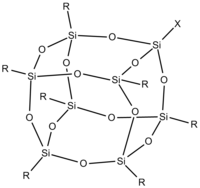
Photo from wikipedia
Polycondensation of α,ω-disilanols is a foundational technology for silicones producers. Commercially, this process is carried out with strong Brønsted acids and bases, which generates cyclosiloxane byproducts. Homoconjugated acids (a 2:1… Click to show full abstract
Polycondensation of α,ω-disilanols is a foundational technology for silicones producers. Commercially, this process is carried out with strong Brønsted acids and bases, which generates cyclosiloxane byproducts. Homoconjugated acids (a 2:1 complex of acid:base or a 1:1 complex of acid:salt), a seldom used class of silanol polycondensation catalysts, were evaluated for their ability to polymerize α,ω-disilanols while forming low levels of cyclosiloxane byproducts. Homoconjugated acid catalysts were highly active for silanol polycondensation, even when made from relatively mild acids such as acetic acid. Both the acid and base (or cation) component of the homoconjugated species was important for activity and avoiding cyclosiloxane byproduct formation. Stronger acids and bases were found to positively affect reactivity, and the pKa of the acid was found to correlate with cyclosiloxane byproduct formation. The individual components of the homoconjugated species (the acid and base) were ineffective as catalysts by themselves, and compositions with fewer than 2 mol of acid to 1 mol of base were much less reactive. Homoconjugated trifluoroacetic acid tetramethylguanidinium and tetrabutylphosphonium complexes were found to be privileged catalysts, able to give high-molecular-weight siloxanes (Mn > 60 kDa) while generating less than 100 ppm of octamethylcyclotetrasiloxane byproduct. Finally, a mechanism has been proposed where silanols are electrophilically and nucleophilically activated by the homoconjugated species, leading to silanol polycondensation.
Journal Title: ACS Omega
Year Published: 2020
Link to full text (if available)
Share on Social Media: Sign Up to like & get
recommendations!